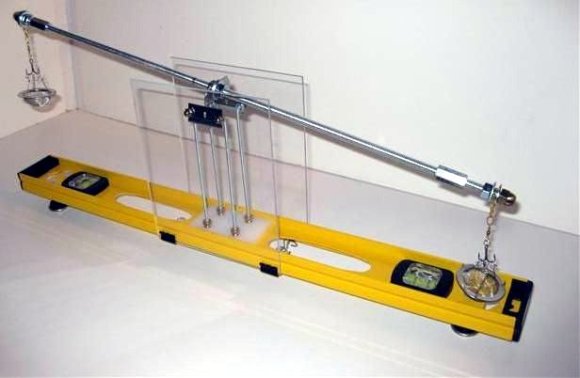
This interesting take on weights and measures uses a two foot long level as the base for a diy equal arm balance. The balance is the oldest method used for measuring mass. That’s because you don’t even need a reference weight for it to work as long as you are measuring ingredients that are proportional to each other in whole numbers.
The key to accuracy with these scales is to reduce friction at the fulcrum. In this case the fulcrum is made of two upturned razor blades on the base, with a single razor blade resting perpendicular to those on the arm. But because gravity is doing the equalization, the base must be as level as possible. Adjustable feet were added to the base so that it can be leveled on two axes. When the tower at the center was built (using threaded rod) a disc level was used to fine-tune the mounting angle of the two razor blades. The finishing touches include a coupling nut on each end for fine-tuning the balance, and the halves of a tea ball strainer as the weighing vessels.















God instrucibles is a horribly designed site intentionally setup to maximize page views, and used by people who lack the knowledge to use a WYSIWYG editors or common blogging software. Why am I not surprised the author seems to be lacking other basic skills. He does know how to drill holes in stainless steel, know how to use a die or thread file, or even bothers to test his scale with check weights.
He goes on to brag that he plans on showing this at his local gem show. I have no idea why because for some reason I would think he would have difficultly having this certified for trade.
And finally it is peppered with ads for a hackerspace in Detriot called TechShop which demands $100 per month for a membership fee and is so poorly stocked they cant even list what tools they have beyond a rotary punch and spot welder
doesn’t know how to drill holes in stainless steel*
Damn matt respectfully did you wake up with a Sunday morning hangover to find out there’s no coffee in the house? ;)
Don’t worry! There is free coffee by the free-to-use microwave in the free kitchenette at TechShop!
Of course walking in the front door costs $1,200 a year…but hey! Once you pay it’s free!
Or medicine.
Isn’t it a necessary function of a balance to be able to tell when it is actually balanced?
There seems to be more thought into getting the base level than measuring actual deflection.
A perpendicular indicator needle against a freely hanging weighted scale and suddenly keeping level the base doesn’t seem so important.
Isn’t that why a fair few scales are suspended by a chain and use a plumb bob style needle?
Ok so unless he plans to use it in a vacuum, that sort of scale needs some kind of enclosure to shield against air currents. I admit I didnt read the actual article because of the critical comments posted here.
Fish-hooks and razor-blades, What could possibly go wrong?
i don’t get why the base has to be perfectly level. the fulcrum and the balance arm has no interaction with the base. when the arm is balanced it will stay balanced even if the base is not level.
Nothing in the Instructable indicates that this intended to be anything more than a novelty item. Even at that the only fair criticism is the lack of an indication when there is a balance, even novelty items should have a sense of functionality. This is always on of those for the hell of it builds that was always in the back of my mind. Now I know not to publish my build, and I do not to do so at Instructables.
Uh, actually, the balance does not care if the base is perfectly level or not. Only the razor blades need to be level.
Missing from this design is an adjustable mass on a vertical axis directly above the center of rotation. This is how the sensitivity of a balance is adjusted. Maximum sensitivity occurs when the center of mass of the beam is a tiny bit below the center of rotation of the balance beam.
I can’t provide much detail beyond the citation from the online Scientific American archive:
Carlson, Shawn. ‘The Amateur Scientist–Homemade Microgram Scale’ Scientific American, v.274, pp.100-101(1996).
As I recall, a really nice arrangement that used a LED photo-interrupt circuilt with built-in tempurature compensation.
A microbalance is not the same beast as a balance arm. Still, the electronics and the fulcrum details would be directly applicable.
BTW, as an all purpose DIY material for an instrument base, use GLASS. You would have to go a very long way to match the thermal AND mechanical stability, availability, cost, and ease of fabrication. Finally, float glass is very flat and uniform.